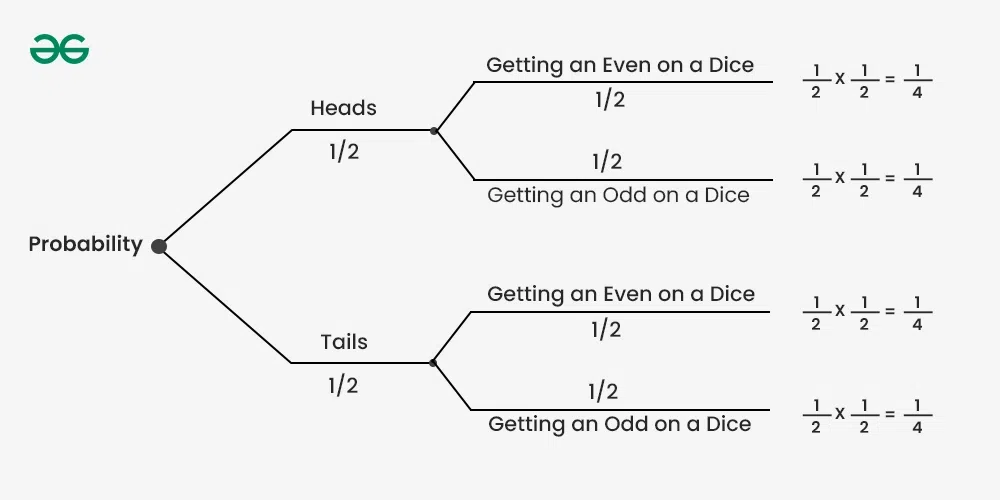
|
What is a Tree Diagram?A tree diagram is a graphical presentation that is used in business statistics to solve problems related to probabilities. A tree diagram is made up of two main parts, nodes and branches. Nodes can be further divided into two types, parent nodes and sibling nodes. The parent node stands for a specific event and always has a probability of 1. Sibling nodes represent other potential events related to the parent event. The branches show the likelihood of these events happening. For example, consider a simple probability tree with just two branches. The first node shows the parent event of flipping a coin. The sibling nodes represent the possible outcomes, heads and tails. Each branch is marked with 0.5, indicating the probability of each outcome. Table of Content Features of Tree Diagram
How to Draw a Tree Diagram?To make a probability tree diagram, you need to find all the possible outcomes and their associated probabilities. Follow these steps: Step 1: Decide if the events depend on each other or happen independently. Step 2: Draw branches to show the initial outcomes. Step 3: Put the probabilities for each outcome on its branch. Step 4: Draw additional branches for the next outcomes, considering if events are dependent or independent. Include the associated probabilities. Step 5: Repeat step 4 as needed. Step 6: To find the total probability, multiply the probabilities along the branches. The sum of these probabilities should always be 1.
Tree Diagram for Conditional ProbabilityA conditional probability tree diagram helps show the outcomes of events that depend on each other. Dependent events are influenced by previous occurrences. For example, Imagine a person buying two different products online. The probability of them liking the first product is 0.6. If they like the first product, the chance they’ll also like the second one is 0.9. However, if they don’t like the first product, the probability of liking the second one drops to 0.4. To find the conditional probability of disliking both products, we can use a probability tree diagram with these steps: Step 1: Draw the probability tree diagram for the first product. The probability of disliking it is 1 – 0.6 = 0.4. Step 2: Create branches for the second product, assuming the person liked the first. Ensure the probabilities sum up to 1 (e.g., 0.9 + 0.1). Step 3: Draw branches for the second product when the person didn’t like the first. Step 4: Multiply the probabilities along each branch to find the conditional probability outcomes.
Tree Diagram in Probability TheoryIn probability theory, a tree diagram is a tool used to represent a probability space. These diagrams can illustrate sequences of independent events, such as a series of coin tosses, or conditional probabilities, like drawing cards from a deck without replacement. 1. Purpose: Tree diagrams help express the likelihood of different outcomes in a systematic way. 2. Components:
3. Application: Tree diagrams are especially helpful when dealing with complex probability scenarios. They provide a visual and structured approach to understanding the probabilities associated with various events. 4. Calculation Aid: When calculating probabilities becomes challenging, the tree diagram serves as a valuable tool. It breaks down the sequence of events and makes it easier to determine the probabilities at each stage. Examples of Tree DiagramExample 1:You toss a fair coin and then roll a six-sided die. Represent this scenario using a tree diagram and find the probability of getting tails on the coin and an even number on the die. Solution:Create a tree diagram to show the possible outcomes of the coin toss and the dice roll. Assign probabilities to each branch. The probability of getting tails on the coin is
Calculate the probability of the specific event (getting tails on the coin and an even number on the die) by multiplying the probabilities along the path, P (Tails and Even) = P(Tails) × P(Even/Tails) P (Tails and Even) = P (Tails and Even) = ∴ The probability of getting tails on the coin and an even number on the die is Example 2:Suppose there are two baskets, Basket A and Basket B. In Basket A, there are apples and oranges in the ratio of 3:7. Basket B contains bananas and grapes in the ratio of 1:1. If you first randomly choose a basket and then randomly select a fruit from the chosen basket, create a probability tree diagram representing this scenario. Find the probability of selecting an apple from Basket A and a grape from Basket B. Solution:Probability of Choosing Basket A = Probability of Choosing an Apple from Basket A = Probability of Choosing an Orange from Basket A = Probability of Choosing Basket B = Probability of Choosing a banana from Basket B = Probability of Choosing a grape from Basket B = The required probability of choosing an apple from basket A = The required probability of choosing a grape from basket B = Hence, the probability of selecting an apple from basket A and a grape from basket B =
|
Reffered: https://www.geeksforgeeks.org
| Commerce |
Type: | Geek |
Category: | Coding |
Sub Category: | Tutorial |
Uploaded by: | Admin |
Views: | 13 |

